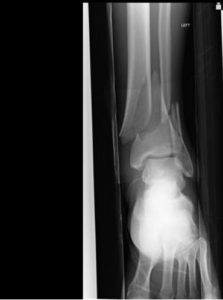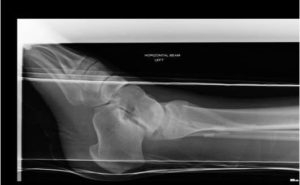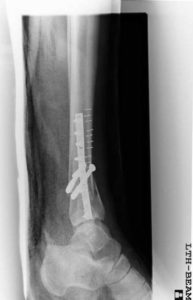Introduction
Compartment Syndrome is one of the few orthopaedic emergencies and rarely occurs in the foot, it is defined as an increase in pressure within a myo-fascial compartment which causes impairment to the blood flow of the tissues within that compartment. Early diagnosis and treatment of compartment syndrome is vitally important, if left untreated the long-term sequelae of foot compartment syndrome includes muscle fibrosis and contracture (Bottle et al, 1996). This leads to deformity, dysfunction, weakness, paralysis, sensory neuropathy and possible chronic pain. The forefoot and toes become clawed and the foot becomes immobile states Bottle et al (1996).
Foot compartment syndrome is most often associated with high-energy injuries such as those sustained after a fall from height, crush injury, or motor vehicle collision. Myerson and Manoli (1993) found that the overall incidence of compartment syndrome of the foot associated with crush injuries was 41% and with calcaneus fractures was 17%.
There is no uniformly accepted anatomical definition of the foot compartments, the number and location of identified compartments has varied in the literature (Sheriff, 1990; Ling and Kumar, 2008; Reach et al, 2007; Manoli and Weber, 1990).
The paucity of soft tissue surrounding the foot and found within its compartments makes the clinical diagnosis of foot compartment syndrome challenging for the surgeon. Myerson (1991) looked at 12 patients with 14 cases of foot compartment syndrome and found that the most common physical finding was simply pain in the foot, which was present in 100% of patients. Pain on passive dorsiflexion of the toes was found to be the most reliable clinical finding and occurred in 86% of patients however, Myerson (1991) also highlighted the difficulty in distinguishing injury pain from that of an impending compartment syndrome. Alternative physical findings were less common in the study group: loss of palpable pulses (86%, with loss of doppler signal in 14%), decreased sensation to light touch (54%), motor deficit (23%), and loss of pin prick sensation (15%). Due to the difficulty of diagnosis (especially in the scenario of crush injury with associated fractures) it is recommended by several authors (Kim and Worsing, 1990; Bayer et al, 2001) that suspected foot compartment syndrome should be confirmed by compartment pressure measurements. This differs from managing compartment syndromes in other areas of the body, in that the diagnosis can be justified on the clinical findings alone (Elliot and Johnstone, 2003). This Article outlines an interesting presentation of foot compartment syndrome after an ankle operation.
Case Presentation
A 34 year old male tree surgeon had his leg crushed by a falling tree, he was admitted with a fracture of the left lateral malleolus and distal tibia. The patient’s hindfoot and midfoot were non-tender and free of bony or ligamentous injury. He was placed into a below knee back slab and listed for open reduction and internal fixation (ORIF) on the next day.

Fig 1. AP View Fracture Distal Tibia

Fig 2. Lateral View Fracture Distal Tiba
The original management plan was to internally fix the large medial fragment with an internal Tibial condylar fixation plate, and similarly internally fix (via plate) the lateral side. The following day in theatre an 8 hole plate was placed on the lateral side and (due to the blisters restricting the incision length) 2 x 6.5mm cannulated screws were inserted on the medial side.

Fig 3. AP View Post Open Reduction and Internal Fixation (ORIF)

Fig 4. Lateral View Post ORIF
On day 1 post ankle fixation, the foot was elevated on a Braun frame, but the patient was still complaining of severe pain in the foot despite being on a PCA pump with regular Paracetamol and on demand Oramorph. He also complained of parathesia over the plantar aspect of the foot. Physical examination demonstrated intense pain on passive dorsiflexion of the great toe, whilst the posterior tibial and dorsalis pedis pulses were palpable. The observations were stable temperature 36.8 degrees, heart rate 72 per min and Blood pressure was 110/65.
This lead to a high index of suspicion for compartment syndrome of the foot rather than the leg as the patient was not complaining of any calf pain. The compartment pressures were measured on the ward and were as follows; 35mmhg for the flexor compartments and 33mmhg for the extensor compartments. Compartment pressures in the leg were also measured, we found the anterior compartment, lateral compartment, superficial posterior and deep posterior compartments to be 20, 12, 12 and 18mmhg respectively. These pressure measurements supported the likely diagnosis of compartment syndrome of the foot but not of the leg (Elliot and Johnstone, 2003).
The patient was prepared for theatre and a fasciotomy was performed by the senior author via 2 dorsal incisions over the 1st and 4th web spaces. Intra-operative findings revealed the interosseous foot muscles were indeed under pressure as they instantly bulged through the incision sites, confirming our clinical diagnosis. The muscles were also healthy as they appeared pink in colour, bled well and contracted well confirming their viability. On review in recovery the patient’s pain levels had completely resolved.
The patient was taken to theatres on two further occasions, 2 and 6 days following the fasciotomy. On day 2 the first check was done with partial closure of one of the wounds. Continued monitoring of this patient and fasciotomy wounds took place up until the day 6 closure of the fasciotomy wounds, at day 8 the patient was discharged.
Conclusion
Foot compartment syndrome decompression has been described in many ways, including 2 dorsal incisions for access to forefoot compartments with 1 medial incision for decompression of calcaneal, medial, superficial, and lateral compartments (Manoli and Weber, 1990; Andemahr, 2001). More recent publications suggest that a medial or modified medial fasciotomy technique should be used. Despite the previous descriptions, the paper by Ling and Kumar (2008) advocates a single incision is all that is necessary to adequately manage compartment syndrome of the foot.
After trauma to the foot subsequent compartment syndrome is an uncommon entity and is rarely reported after trauma to the ankle, the literature has four reports in adults (Kym and Worsing, 1990; Dhawan and Doukas, 2003; Guo et al, 2010; Maurel et al, 2007). A missed diagnosis of foot compartment syndrome can lead to severe long-term sequelae of foot deformity, immobility, and chronic pain. A high index of suspicion for an acute foot compartment syndrome in addition to leg compartment syndrome is warranted in patients who have sustained an ankle injury or after fixation of fractures of the distal lower extremity. The classic clinical findings of compartment syndrome are less reliable in the foot, and intercompartmental pressure measurements may be necessary for diagnosis.
This case report raises awareness of the uncommon foot compartment syndrome occurring after a very common injury of an ankle fracture combined with a crush injury.
The case report highlights the importance of keeping a high index of suspicion when treating any crush injury, being careful to not be distracted by any associated bony injury. This patient had a good initial outcome due to prompt intervention, the authors quite rightly took the approach to this injury as a ‘soft tissue injury that happened to have an associated broken bone’.
List of Abbreviations
AP — Anterior Posterior
MMHG — Millimetres of Mercury
ORIF — Open Reduction and Internal Fixation
PCA — Patient Controlled Analgesia
Consent
Written informed consent was obtained from the patient for publication of this Case report and any accompanying images. A copy of the written consent is available for review by the Editor of this journal.
Competing Interests
The author(s) declare that they have no competing interests.
Authors Contributions
WE participated in the study design, performed the background literature search and helped draft the manuscript.
AG conceived of the study, was involved in the clinical diagnostic side of the report, helped draft the manuscript.
IN participated in the study design, helped with the literature search, and drafted the final manuscript.
SS Participated in the surgery of the patient and assisted with the literature search. All authors read and checked/approved the final manuscript.
References
Andermahr, J., Helling, H. J., Tsironis, K., Rehm, K. E. & Koebke, J. (2001). “Compartment Syndrome of the Foot,” Clin Anat. 14(3) 184-189.
Publisher – Google Scholar – British Library Direct
Bayer, J. H., Davies, A. P., Darrah, C., Shepstone, L. & Patel, A. D. (2001). “Calcaneal Compartment Syndrome after Tibial Fractures,” Foot Ankle Int. 22(2) 120-122.
Publisher – Google Scholar – British Library Direct
Botte, M. J., Santi, M. D., Prestianni, C. A. & Abrams, R. A. (1996). “Ischemic Contracture of the Foot and Ankle: Principles of Management and Prevention,” Orthopedics. 19(3):235-244.
Publisher – Google Scholar – British Library Direct
Dhawan, A. & Doukas, W. C. (2003). “Acute Compartment Syndrome of the Foot Following an Inversion Injury of the Ankle with Disruption of the Anterior Tibial Artery. A Case Report,” J Bone Joint Surg Am. 85(3) 528-532.
Publisher – Google Scholar – British Library Direct
Elliot, K. G. B. & Johnstone, A. J. (2003). “Diagnosing Acute Compartment Syndrome,” J Bone Joint Surg Br. 85-B(5) 625-32.
Publisher – Google Scholar – British Library Direct
Guo, S., Sethi, D. & Prakash, D. (2010). “Compartment Syndrome of the Foot Secondary to Fixation of Ankle Fracture —A Case Report,” Footanklesurg. Epub 16(3) 72-5.
Publisher – Google Scholar
Kym, M. R. & Worsing, R. A. Jr. (1990). “Compartment Syndrome in the Foot after an Inversion Injury to the Ankle. A Case Report,” J Bone Joint Surg Am 72(1) 138-139.
Publisher – Google Scholar
Ling, Z. X. & Kumar, V. P. (2008). “The Myofascial Compartments of the Foot: A Cadaver Study,” J Bone Joint Surg Br90(8) 1114-1118.
Publisher – Google Scholar
Manoli, A. II & Weber, T. G. (1990). “Fasciotomy of the Foot: An Anatomical Study with Special Reference to Release of the Calcaneal Compartment,” Foot Ankle. 10(5) 267-275.
Publisher – Google Scholar
Maurel, B., Brilhault, J., Martinez, R. & Lermusiaux, P. (2007). “Compartment Syndrome with Foot Ischemia after Inversion Injury of the Ankle,” J Vasc Surg 46(2) 369-371.
Publisher – Google Scholar
Myerson, M. & Manoli, A. (1993). “Compartment Syndromes of the Foot after Calcaneal Fractures,” Clin Orthop Relat Res. (290) 142-150.
Publisher – Google Scholar – British Library Direct
Myerson, M. S. (1991). “Management of Compartment Syndromes of the Foot,” Clin Orthop Relat Res (271) 239-248.
Publisher – Google Scholar
Reach, J. S. Jr, Amrami, K. K., Felmlee, J. P., Stanley, D. W., Alcorn, J. M. & Turner, N. S. (2007). “The Compartments of the Foot: A 3-Tesla Magnetic Resonance Imaging Study with Clinical Correlates for Needle Pressure Testing,” Foot Ankle Int. 28(5) 584-594.
Publisher – Google Scholar – British Library Direct
Shereff, M. J. (1990). “Compartment Syndromes of the Foot,” Instr Course Lect (39) 127-132.
Publisher – Google Scholar







